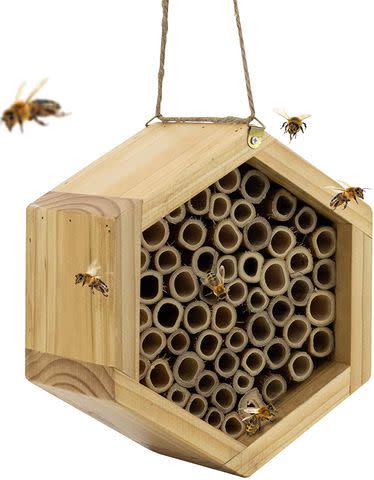Help One of Your Favorite Pollinators Thrive with a Cute Bee House
A healthy, thriving garden needs plenty of pollinators, and these shelters are an easy way to roll out the welcome mat.
Native bees, such as mason and leafcutter bees, are a significant part of pollination. Compared to honeybees, native bees are "two to three times better pollinators," says Bryan Danforth, an entomology professor at Cornell University in New York. Sadly, more than half of North America's bee species are declining, with almost 25% at risk of extinction. One easy way to help native bees is to offer them a safe place to live in your backyard, and you don't have to be a professional beekeeper to make a difference.

Most bee species don't live together in hives as honeybees do; they are solitary and don't make or store honey. Try hanging up an affordable bee house to help these critical pollinator populations thrive.
Buy It: Mason Bee House ($15, Amazon)
Because they don't have a hive or honey supplies to protect, most native bees are less aggressive than honeybees and rarely sting. Mason bees are some of the most common native species, and they need small, narrow places to nest where they can close up the ends for protection. The Mason Bee House ($18, Amazon) provides a bundle of bamboo tubes held in a hexagonal frame that can house several mason bees at once. Rivajam also offers a best-selling Mason bee house ($36, Etsy).
:The Best Nectar Plants for Pollinators
Placing Your Native Bee House
Situate your bee house up high in your yard in a spot that gets morning sunlight. To attract native bees, plant native plants and flowers around where your bee house is hanging. Add a moist patch of soil near the house so the bees can access mud to close off the tubes. It's also best to practice organic gardening without using pesticides near where bees are.
Test Garden Tip: While native bees rarely sting, keeping those with bee allergies in mind is important. Place your bee house away from high-traffic areas to minimize the chance of disturbing the insects to the point where they feel they need to protect themselves.
How to Harvest Bee Cocoons
After the mason bees have laid their eggs, you'll need to do a small amount of upkeep to make sure unwanted pests stay out of the cocoons. In the fall, remove the cocoons from reeds, bamboo, or reusable wood trays—you can store them in your garage or shed over the winter. Next, clean out the wood trays, discard used nesting tubes, and check for signs of parasitic wasps, pollen mites, or fungal infections like chalkbrood.
Although bees sometimes get a bad reputation, not all bees are aggressive. Native species like mason bees have tons of pollinating power to help your vegetables, fruits, herbs, and flowers thrive, and they mostly keep to themselves. Taking a few steps to help them out will benefit your whole garden's ecosystem.
:How to Create a Beautiful Pollinator Garden for Butterflies and Bees
false
